Ependymoma Awareness Day Sparked Community with Ependymoma Patients Like Tiffany
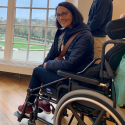
Name: Tiffany M.
Type of Cancer: Ependymoma
Diagnosed: 2014
By: Tiffany M.
— Categories:
In 2022 on Ependymoma Awareness Day, the CERN Foundation welcomed ependymoma patients from around the country to join a Zoom support call and share their stories. Tiffany M. attended the call and benefited from the opportunity to connect to others in the community, tell her story, and encourage others.
“It was encouraging to me because you saw and heard other people who likewise didn’t necessarily have the smoothest path forward after their tumor resections,”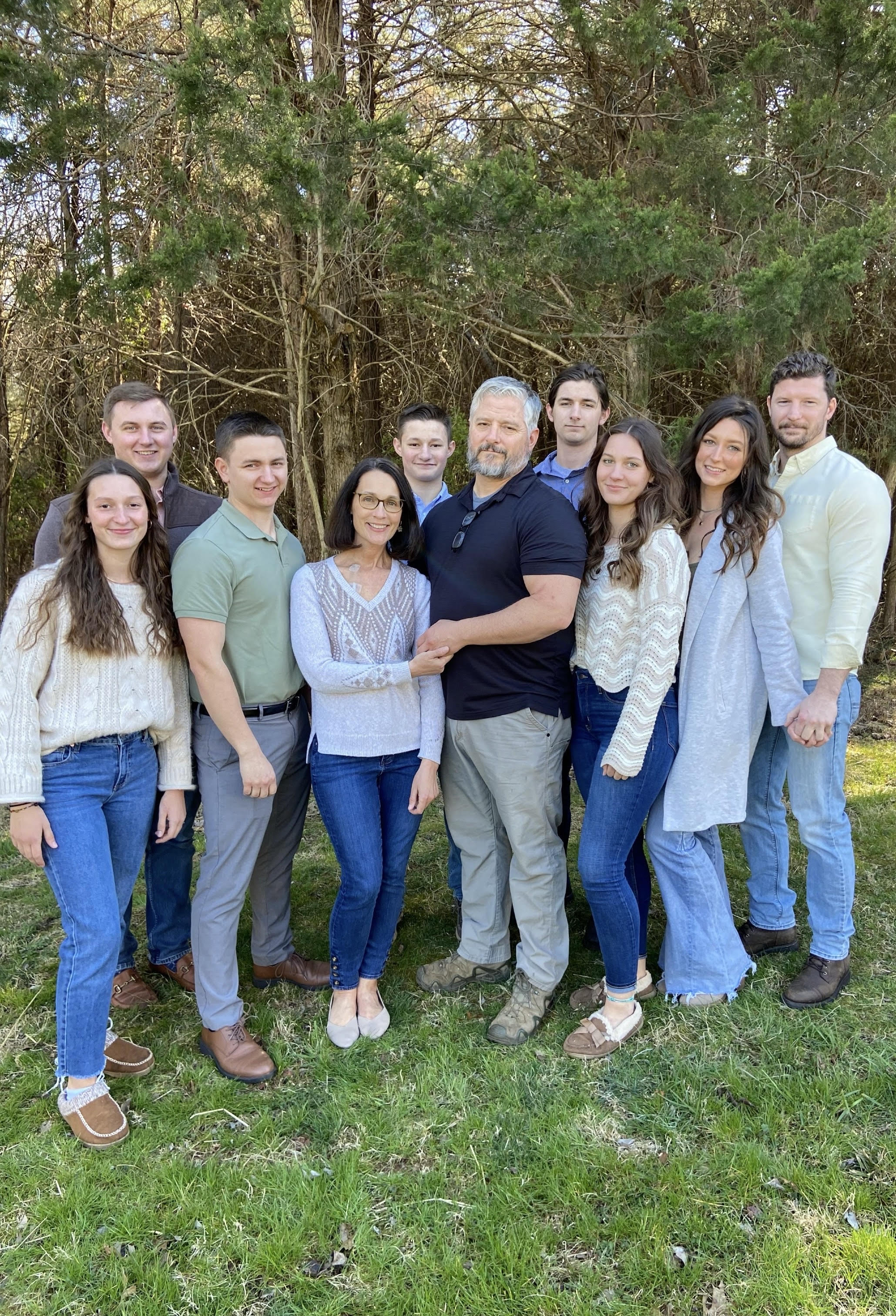 Tiffany said. “You don’t want anybody to go through what you’ve gone through, but there is some comfort in feeling like you’re not alone. We were able to hear each other’s stories and also encourage each other.”
Tiffany said. “You don’t want anybody to go through what you’ve gone through, but there is some comfort in feeling like you’re not alone. We were able to hear each other’s stories and also encourage each other.”
For many, a cancer diagnosis can be a lonely experience. With a rare disease, it can seem like no one truly understands what the patient is experiencing. Events like Ependymoma Awareness Day can help foster community when people need it the most, creating a welcoming space for individuals to exchange stories and form lasting bonds as members of the brain and spinal cord tumor community.
“I know there are other people out there who have ependymoma, and my mind can rationalize that I’m not actually alone,” Tiffany said. “But it was such an encouragement when you can talk with people who truly get what you’re going through. My family and friends can sympathize with my pain, struggles, losses, and ongoing health issues, but they can’t empathize. It gave me strength and resolve.”
This virtual gathering on Ependymoma Awareness Day allowed patients to connect directly with others experiencing similar challenges, symptoms, and treatments.
“I’m listening to his story, and he’s talking about these 7-10 level pain days, and he’s talking about the constant buzzing he feels throughout his body every day,” Tiffany said. “Someone else said she gets ripples through her body, and she feels bugs crawling up her legs. They were describing my new normal. There’s strength in numbers. You feel less isolated. I walked away from that Zoom support group just feeling a little lighter. I’m not alone.”
It was a welcome feeling for Tiffany after years of processing a diagnosis and treatment.
Getting Diagnosed
After a day spent painting her master bathroom in October 2014, Tiffany experienced neck pain that seemingly came out of nowhere. She reasoned that it was from one of the weird positions required to paint in some tight corners, but the pain worsened over time. Five weeks later, after a standard X-ray, two rounds of steroids, and three weeks of physical therapy, the pain became excruciating. Tiffany found it increasingly difficult to use her dominant right arm. It was then that insurance agreed to the MRI.
She knew something more significant must be wrong when her doctor called her within 45 minutes of her MRI scan on a Saturday afternoon. Instead of the MRI confirming a disc-related issue, the scan revealed a 6 cm tumor filling the inside of her spinal cord from C2-C5.
“Two days later, I had my first consultation with the top neurosurgeon in our area,” Tiffany said. “He had no idea how I didn’t have more neurological impairment. The following day I had a second opinion. The second opinion told me to go to the first opinion. I was so thankful for that affirmation!”
It was a lot for Tiffany, who had always been healthy and active, to take in. As a mom to seven, her days were spent homeschooling her kids, taking kids to extracurricular activities, doing projects, and visiting friends. All of a sudden, life changed completely. Her faith and family were the two driving forces behind her “must keep moving forward attitude” in those early days.
Undergoing Surgeries
Little did Tiffany know that the initial eight-hour surgery to resect her grade 2 ependymoma would be the first of six more to come.
Two weeks after the first surgery, Tiffany ended up with an infection at the surgery site and needed two follow-up surgeries to clean out and close up the wound. That summer, Tiffany felt stronger and was improving at physical therapy.
It all abruptly changed in November when she once again lost the feeling in her feet. As Tiffany experienced increased numbness in her body and a return of the pain in her neck, she underwent another MRI. It revealed that her spinal cord had stuck itself to the spinal canal in a process called spinal tethering, and the spinal column itself was falling forward from lack of support from the loss of the bone and hardware after the infection.
Her neurosurgeon took a wait-and-see approach, but her neurological decline continued. She was back in the operating room in June 2016 to untether her cord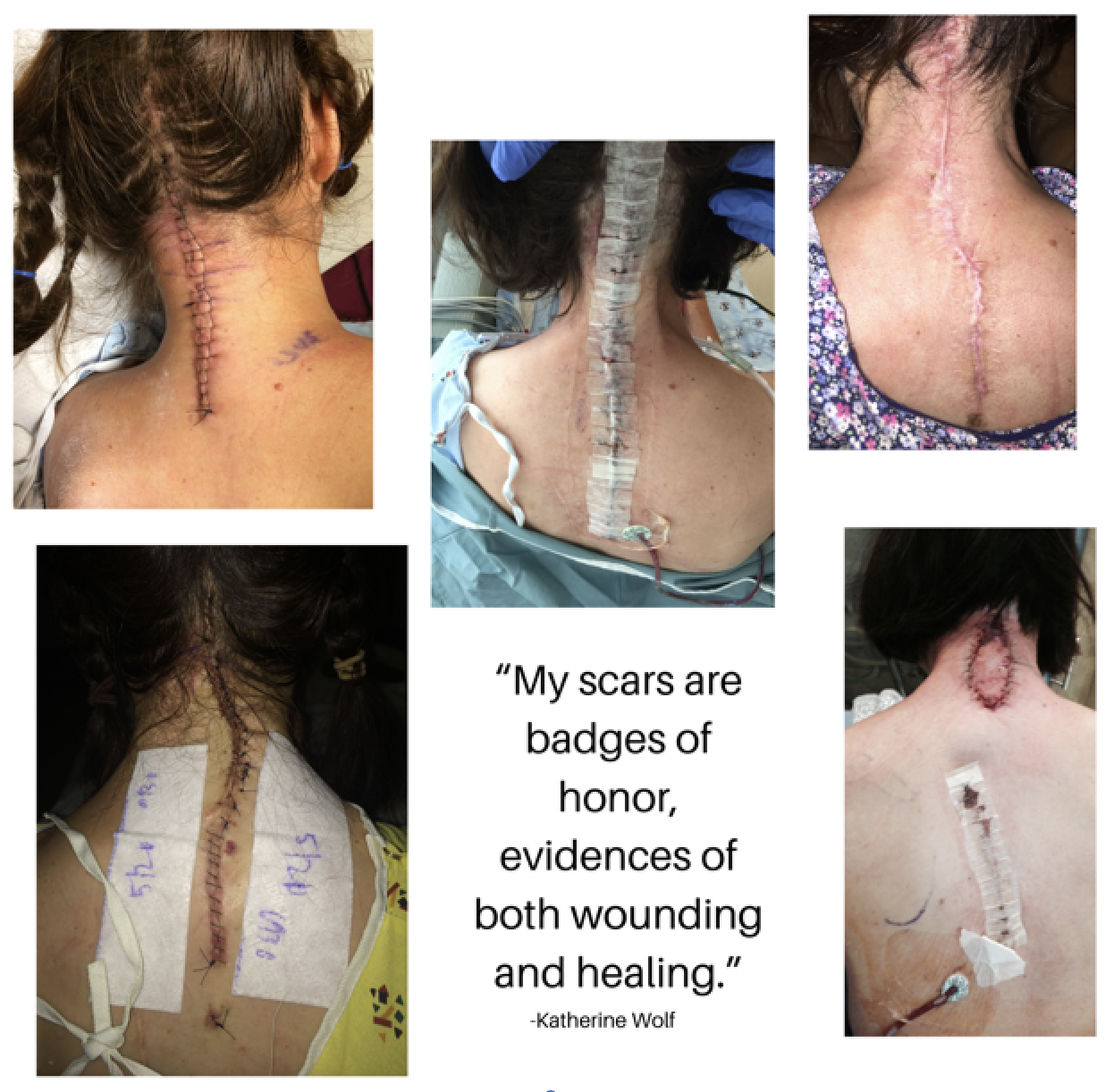 from C3-T1 and fuse her spinal column from C2-T2.
from C3-T1 and fuse her spinal column from C2-T2.
“It was like pushing the restart button on all the progress I had made in my physical therapy,” Tiffany said. “I spent another four weeks in the hospital and then jumped right back into outpatient physical therapy.”
In early August 2016, one of Tiffany’s children asked what was wrong with her neck. Overnight, all the tissue under her skin had atrophied, leaving the spinous processes in her lower cervical and upper thoracic spine, poking right under a paper-thin layer of skin. Her neurosurgeon worked with a plastic surgeon in the OR to remove all the spinous processes and graft the area to her neighboring muscles.
“The setbacks of those two years did not make sense to me,” Tiffany said. “It didn’t even seem like you could make this stuff up. It all seemed so bizarre, but I continued to hold fast to God.”
By the end of 2016, an MRI revealed that her spinal cord had again tethered, and they scheduled surgery for the end of March. Two weeks before the surgery, she underwent a cervical CT myelogram. This process involves the health care team injecting dye into the spinal cord and looking at a series of pictures to determine the significance of the tethering. Just 24 hours later, Tiffany was admitted to the hospital with full-blown meningitis.
“It was pain unlike anything I had ever experienced, including childbirth and each post-op period after the surgeries,” Tiffany said. “The chemical meningitis had caused an increase in the intracranial pressure, requiring repeated spinal taps to monitor the pressure and determine when it was safe to go forward with the postponed untethering surgery.”
An anaphylactic reaction on the operating table from the antibiotic they gave before the start of surgery in May 2017 sent Tiffany home for a few days. The surgery took place a week later. After a few weeks in the hospital, she was discharged home to continue with her physical and occupational therapy.
Everything seemed to be going smoothly until January 2018, when her classic “tethering signs” returned. After discussing her case with the head of neurosurgery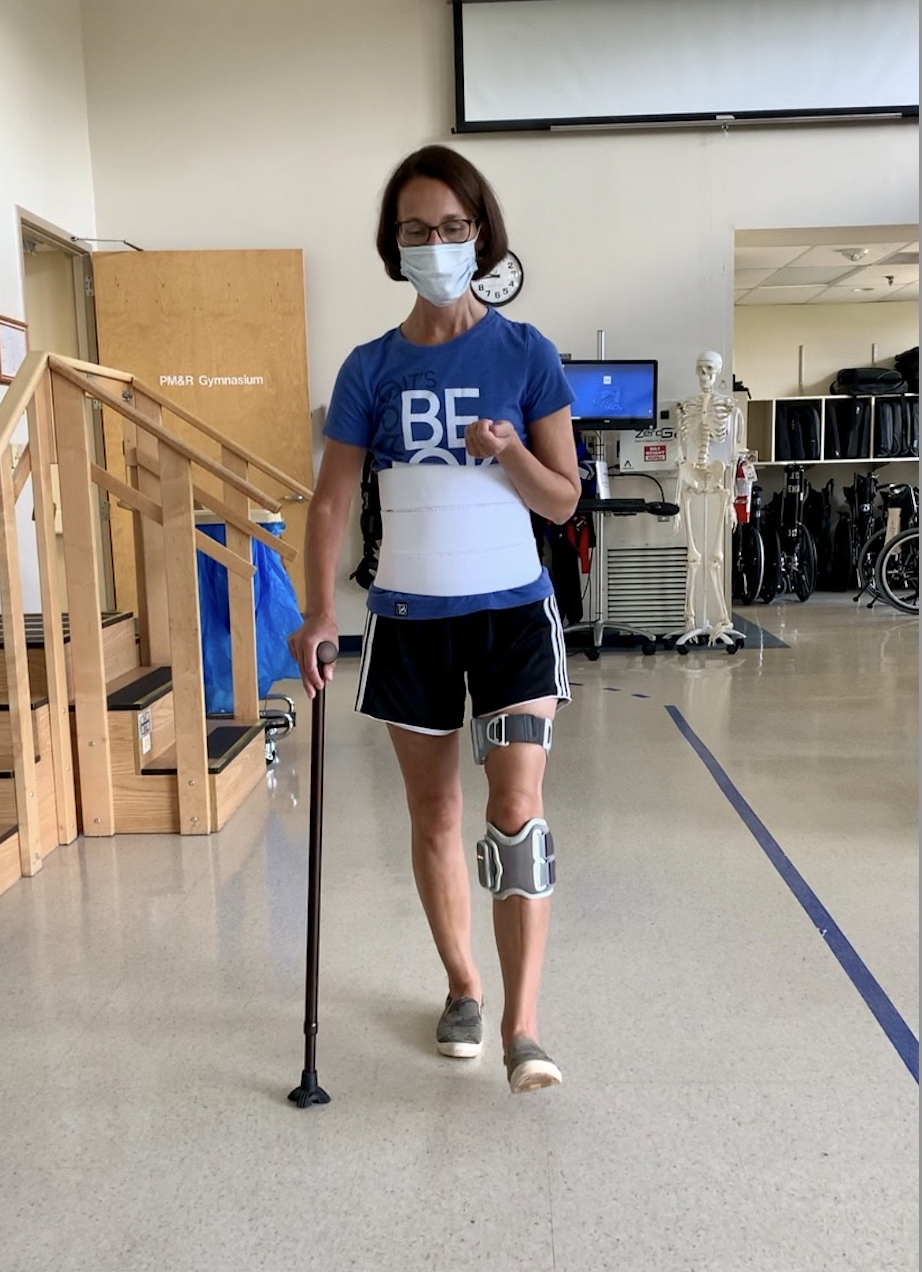 at the National Institutes of Health (NIH), they determined that Tiffany’s neurosurgeon would untether her cord for the third time. Following surgery, she would remain in a prone position for six weeks in an attempt to keep the cord from adhering to the back of the canal.
at the National Institutes of Health (NIH), they determined that Tiffany’s neurosurgeon would untether her cord for the third time. Following surgery, she would remain in a prone position for six weeks in an attempt to keep the cord from adhering to the back of the canal.
“We rented equipment that would enable me to lay face down during the night, and sit bent over, face down, during the day,” Tiffany said. “I went into that recovery slightly naïve, but I think it was better that way. Spasms racked my whole body as it adjusted to being in a face-down position hour, after day, after week. I had abrasions on my knees, elbows, and face. Only by God’s grace did I have the resolve to remain committed to this unorthodox recovery plan. It was plain awful.”
The struggle of six weeks in a prone position paid off as Tiffany’s spinal cord continues to remain untethered. Unfortunately, the fallout from two bouts of chemical meningitis and the many spinal cord surgeries has developed into myelomalacia (atrophy of the cord), syringomyelia (a fluid-filled cyst), spinal pseudoathetosis (involuntary movements on exertion), and complex regional pain syndrome — not to mention the sensory and motor loss to the left side of her body, the requirement of a feeding tube for nutrition, and the use of a wheelchair when out and about.
“Multiple doctors, in numerous specialties, at the Mayo Clinic evaluated me over two weeks,” Tiffany said. “The takeaway based on my images was that they were shocked I could even get out of my wheelchair and walk with a cane. They were shocked that the damage in my spinal cord had not left me with even more mobility, function, and sensory deficits. They also left me with a sobering reality: it wouldn’t take much, a fall or an accident, to completely sever my very thinned cord.”
Receiving Support from CERN
There is not always a clear road map for people navigating care after treatment and throughout survivorship. Although Tiffany has consulted with multiple institutions for expert opinions, she was still in need of a provider to help manage ongoing issues she deals with that impact her quality of life. Tiffany reached out to CERN for support. The Personalized Support and Navigation team worked with the NIH NCI-CONNECT Clinic to identify a neuro-oncology provider that would be willing to join her care team.
“That just shows the heart behind the foundation,” Tiffany shared. “The whole organization has been a tremendous encouragement. Not just a source of information, but there’s this personal contact that I think is so important, especially the rarer the cancer is.”
Over the years, Tiffany has encouraged her children to make artwork as part of Ependymoma Awareness Day and the surrounding week. Her daughters, in particular, were excited to participate and made butterfly chalk art, while her oldest son held an online fundraiser two years ago.
“He spotlighted me through social media, email, and word of mouth to raise some money and donate it to CERN,” Tiffany shared. “All of my family — my children, husband, and parents — have seen what this ependymoma diagnosis has done for our life, and it’s been hard. There’s been a lot of good that’s come from it as well, and it was fun to participate in something like that.”
Ependymoma Awareness Day has served as a platform for Tiffany's family and friends to show support, express their experiences, and stand in solidarity with her.
Commemorating Ependymoma Awareness Day: May 10, 2023
Join patients like Tiffany, care partners, friends, and family for Ependymoma Awareness Day this year on Wednesday, May 10, and help shine a light on this poorly understood disease.
This year, Tiffany is working with her daughter’s gymnastics gym to hold a fundraiser ahead of Ependymoma Awareness Day to fundraise for the CERN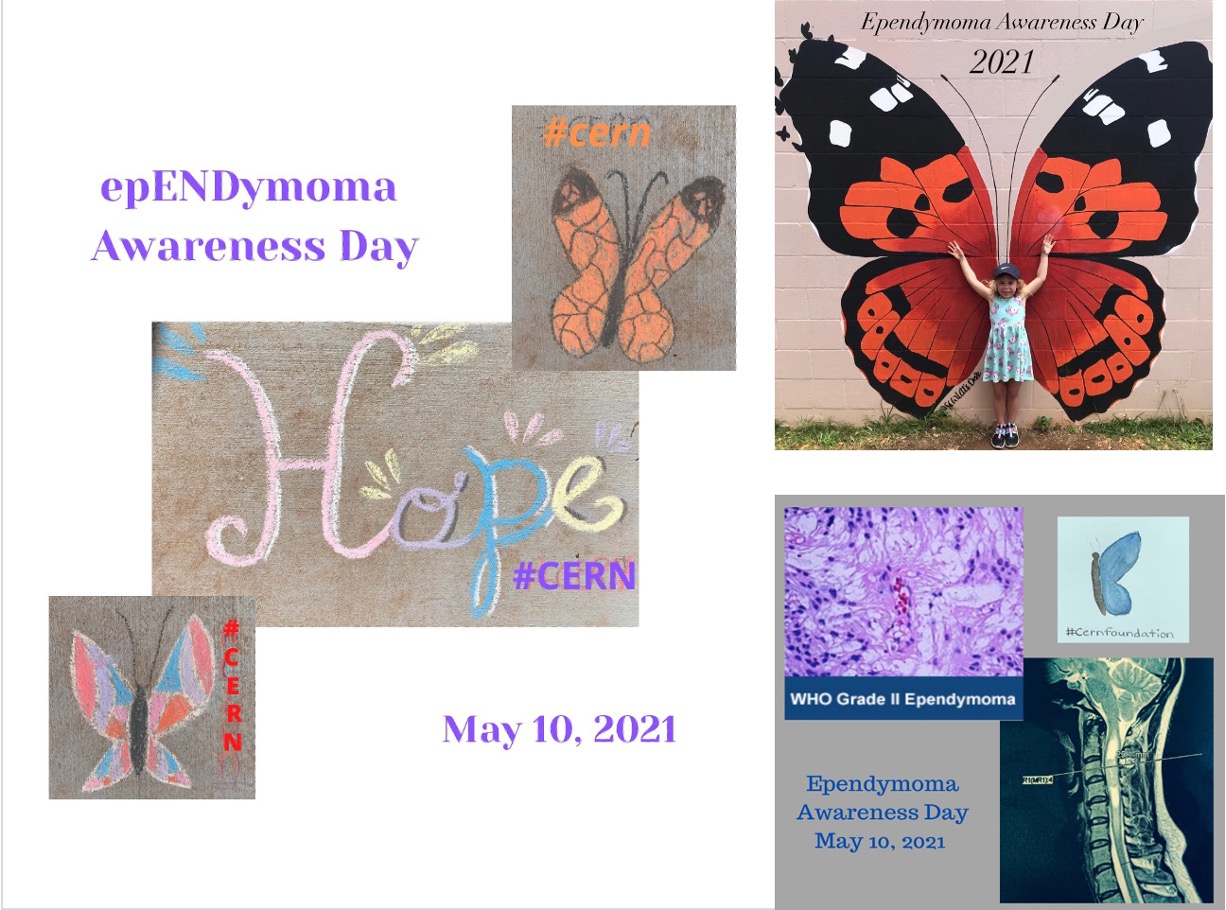 Foundation. She also plans to travel to Washington, D.C., and participate in Race for Hope DC on Sunday, May 7. Tiffany and her oldest son formed a team called Grace and Grit.
Foundation. She also plans to travel to Washington, D.C., and participate in Race for Hope DC on Sunday, May 7. Tiffany and her oldest son formed a team called Grace and Grit.
“I see how ependymoma has upended my life,” Tiffany said. “I feel like Ependymoma Awareness Day casts a spotlight on the gift of hope. Hope that if you’re in the middle of it, there are people there who want to support you and navigate for you. Hope that in the future, they will come up with the means to either eradicate it, cut down the number of cases, or have a gentler treatment of it. It seems fitting that a butterfly — a symbol of hope through change — was chosen to represent the spirit of the ependymoma community. Friends in this fight…don’t give up. Hold fast to hope!”
